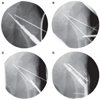Abstract
Purpose
The purpose of this study was to introduce our method of stabilizing unstable intertrochanteric fractures by using the dynamic hip screw (DHS) with a beta-tricalcium phosphate (β-TCP) graft and to compare the outcomes of this procedure with those of the conventional DHS without β-TCP.
Materials and Methods
Patients who underwent surgery by using DHS between March 2002 and January 2016 were retrospectively reviewed for analysis of the outcomes. The inclusion criteria were: 1) age of 60 years and older; 2) low-energy fracture resulting from a fall from no greater than the standing height; 3) multifragmentary pertrochanteric fracture (AO classification 31-A2.2, 2.3); and 4) follow-up of over 3 months. We compared 29 patients (29 hips) who underwent surgery, using DHS without β-TCP, with 29 age-sex matched patients (29 hips) who underwent surgery using DHS with grafted β-TCP granules to empty the trochanter area after reaming. We investigated the fracture union rate, union time, and length of lag screw sliding.
Figures and Tables
 | Fig. 2A 79-year-old female patient. (A) Intraoperative C-arm image shows reaming lag screw. (B) Impaction beta-tricalcium phosphate (β-TCP) granule to lessor trochanter area. (C) Impaction β-TCP granule to greater trochanter area. (D) Post-fixation status. |
 | Fig. 3The Doppelt's method. To measure the extent of sliding, a correction factor was applied. Correction factor=B/b, the extent of sliding=A−a×B/b. |
 | Fig. 4Serial follow-up x-ray of the 70-year-old female patient. (A) Preoperative radiograph shows 31-A2.2 type trochanteric fracture. (B) Immediate postoperative radiograph after surgery using beta-tricalcium phosphate. (C) Postoperative radiograph at the 3-month follow-up. (D) Postoperative radiograph at the 12-month follow-up. |
Table 1
Patients Demographics of the Cohort

References
1. National Health Insurance Service. NHIS statistical information system [Internet]. Wonju: National Health Insurance Service;2015. Oct 19. Available from: http://www.nhis. or.kr/bbs7/boards/B0039/15329.
2. Jensen JS, Sonne-Holm S, Tøndevold E. Unstable trochanteric fractures. A comparative analysis of four methods of internal fixation. Acta Orthop Scand. 1980; 51:949–962.

3. Koval KJ, Zuckerman JD. Hip fractures: II. Evaluation and treatment of intertrochanteric fractures. J Am Acad Orthop Surg. 1994; 2:150–156.

4. Sambandam SN, Chandrasekharan J, Mounasamy V, Mauffrey C. Intertrochanteric fractures: a review of fixation methods. Eur J Orthop Surg Traumatol. 2016; 26:339–353.

5. Laros GS, Moore JF. Complications of fixation in intertrochanteric fractures. Clin Orthop Relat Res. 1974; (101):110–119.
6. Stankewich CJ, Swiontkowski MF, Tencer AF, Yetkinler DN, Poser RD. Augmentation of femoral neck fracture fixation with an injectable calcium-phosphate bone mineral cement. J Orthop Res. 1996; 14:786–793.

7. Lu JX, Huang ZW, Tropiano P, et al. Human biological reactions at the interface between bone tissue and polymethylmethacrylate cement. J Mater Sci Mater Med. 2002; 13:803–809.
8. Stoffel KK, Leys T, Damen N, Nicholls RL, Kuster MS. A new technique for cement augmentation of the sliding hip screw in proximal femur fractures. Clin Biomech (Bristol, Avon). 2008; 23:45–51.

9. Fillingham Y, Jacobs J. Bone grafts and their substitutes. Bone Joint J. 2016; 98-B:1 Suppl A. 6–9.

10. Neamat A, Gawish A, Gamal-Eldeen AM. Beta-tricalcium phosphate promotes cell proliferation, osteogenesis and bone regeneration in intrabony defects in dogs. Arch Oral Biol. 2009; 54:1083–1090.

11. Baumgaertner MR, Curtin SL, Lindskog DM, Keggi JM. The value of the tip-apex distance in predicting failure of fixation of peritrochanteric fractures of the hip. J Bone Joint Surg. 1995; 77:1058–1064.

12. Kyle RF, Ellis TJ, Templeman DC. Surgical treatment of intertrochanteric hip fractures with associated femoral neck fractures using a sliding hip screw. J Orthop Trauma. 2005; 19:1–4.

13. Doppelt SH. The sliding compression screw: today's best answer for stabilization of intertrochanteric hip fractures. Orthop Clin North Am. 1980; 11:507–523.

14. Kim KJ, Yang DS, Lee SK, Choy WS, Bae KW. Surgical treatment of femoral unstable intertrochanteric fractures in elderly patients: comparative study between compressive hip screws and additional trochanteric stabilizing plates. J Korean Fract Soc. 2011; 24:295–300.

15. Flores LA, Harrington IJ, Heller M. The stability of intertrochanteric fractures treated with a sliding screw-plate. J Bone Joint Surg Br. 1990; 72:37–40.

16. Davis TR, Sher JL, Horsman A, Simpson M, Porter BB, Checketts RG. Intertrochanteric femoral fractures. Mechanical failure after internal fixation. J Bone Joint Surg Br. 1990; 72:26–31.

17. Min BW, Lee KJ. Treatment of intertrochanteric fracture: dynamic hip screw. J Korean Fract Soc. 2009; 22:51–55.

18. Lindner T, Kanakaris NK, Marx B, Cockbain A, Kontakis G, Giannoudis PV. Fractures of the hip and osteoporosis: the role of bone substitutes. J Bone Joint Surg Br. 2009; 91:294–303.




 PDF
PDF ePub
ePub Citation
Citation Print
Print




 XML Download
XML Download